
Josephine Pace, our host, in Caltigirone (the famous steps are in the distance)
Rather than give a detailed travelogue, I will touch upon some of the highlights, beginning with the visit with the classical and modern foreign language students in Caltagirone. I figured that they would be sharp as lasers and engaged with the material I'd provided, but what truly blew me away was how enthusiastic this packed room of high schoolers, on a Saturday no less, were. They came ready to ask questions, engage in a dialogue, and hear me talk about and read some of my work. After introductions by the school's principle, one of their language teachers, and Josephine and Giovanni--Josephine broached issues of not just literary but also cultural translation, and Giovanni unknotting some of what he saw as the threads in my work, both talks at a level that struck me as what I'd likely hear in introductions at the college/university level in the US. I read a snippet of a statement I'd sent along beforehand, and which they'd thoroughly read, before reading a few poems, one--"Ten Things I Do Everyday"--in tandem with Giovanni's translation, a bit of prose, and then taking questions. And they were very good ones. One student wanted to know about the relationship between my sense of Annotations as a long poem and the sorts of epic poems they'd explored, like the Iliad and the Aeneid; another wanted to know about the influence of classical music in my work; yet another wanted to know how I began writing poetry; and one of the students was, as any readers of the book are, curious about what Seismosis meant. But this is only tiny portion of the questions I received. A little more than an hour later, we concluded after I read a second poem, "Serenade," that Giovanni had artfully translated into Italian, and then I posed for pictures with the students, whose cheers and excitement really would have been enough to carry us back to JFK if Alitalia hadn't.
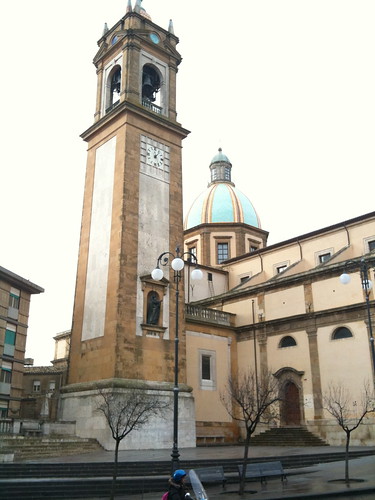
The baroque Cathedral in Caltagirone (note the multicolored dome, covered in locally manufactured tiles)
Between the visit with the Liceo students and the Festival, C and I had a short break, so we decided, after a bit of discussion and with Josephine's and Maria's assistance, to take the bus to see Taormina, one of the important historical cities in Sicily, and its Ionian seafront resort town of Giardini Naxos. To get there, we had to take a bus to Catania, our original flight portal into Sicily, and then connect at the airport via bus to head north. We had thought of driving, but after seeing the aftermath of an accident on our initial trip from Catania to Caltagirone, we decided to place our faith in someone more familiar with the areas roundabouts and autostrade. Because it was winter, Giardini-Naxos was sleepier than it is during the summer months, when people descend from all parts of Sicily, Italy, Europe, and the world to flock its streets and beaches, as many others, from J. W. von Goethe and Oscar Wilde to D.H. Lawrence and Knut Hamsun, have in the past. But it was still lovely to sit out on our balcony overlooking the almost unbelievable vista, or walk along the seafront, watching the clouds and light shift in ever more painterly combinations. We also noted the stylishness of the residents, as we did of those in Caltagirone, a city of 40,000 known primarily for its ceramics industry and baroque architecture; it would be unusual, we concluded, to see such fashionableness in a similarly small American town unless it were very close to a major city. The Sicilians, however, are second to none in style. We also sampled the delicious seafood, highly recommended by our hosts, including one "opener", which included the best preparations of sardines I've ever had (also among these antepasti were squid, octopus, mussels, prawns, and several types of local area fish, prepared in ways I'd never tried before). After this, the delicious pasta was truly an anticlimax.
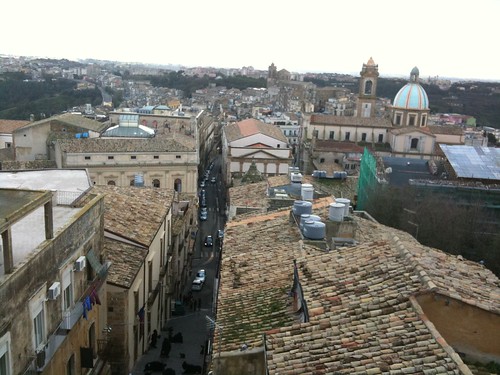
Rooftops of Caltagirone, visible from the Three Steps from Heaven B&B
You cannot visit Taormina and not see Taormina, so we took the bus up the winding, hair-pin curved Via Luigi Pirandello--one of Sicily's famous figures, of course--to the top of the hill, then walked a bit more, before reaching one of the historic gates that led to the main strip, now mostly full of high-end stores familiar (Dolce and Gabbana, Armani) and less so (Danielle Alessandrini, Parisi). We wondered, given the economic climate even in Italy, who could afford to patronize all of these shops full of true fabulousness (the wine or shoes or coats alone would have melted the heart of the most miserly), but they seemed to be doing better than their peers in New York, go figure. Dotting the landscape were the various treasures of the city, such as the 10th century Palazzo Corvaja, the 13th century Duomo, the Renaissance baroque fountain, and a host of other churches and historical sites, including a police headquarters that had regularly-spaced Stars of David carefully carved into its facade, leading us to believe that it had once been a noteworthy building for the Jewish population in the area. Two of the most important sites we ventured to: the beautiful Public Garden (Giardino pubblico), which surprised me primarily because of the large number of cacti (!) specimens on view--a particular type of prickly pear cactus, the Fico d'India, is a Sicilian specialty and symbol--and because it appeared to be a cute cat hangout; and the Greek(-Roman) Theater (Teatro Greco), perched on a seemingly-impossible promontory, with some of the most spectacular vistas imaginable, and still mostly standing despite having been erected in the 3rd century BCE (and then rebuilt, in the Roman style, in the 2nd century BCE). We wandered beneath it, alongside tourists from Spain and Germany, and then climbed up to the top to take pictures, stare in amazement, and consider the countless layers of history that it embodied. We also learned that if you are there at the right times, you can see performances of classical plays on its main stage, or musical events. I highly recommend it whatever the season.

Some of the Liceo students before my presentation, in Caltagirone
Returning to Caltagirone a few days later, we stayed on the Piazza Umberto, just a stone's throw from the city's main cathedral, whose dome is covered with some of the locally-produced, beautiful, multicolored tiles. As we did before heading north, we saw some of the Old (la Città Vecchia) and New City (la Città Nuova), the old being what had been rebuilt since 1697, after an earthquake destroyed much of the medieval and earlier foundations, leading to the city's distinctive baroque architecture, and the new city spreading outwards down the mountain. Among the sights we visited was the Villa Patti, with its polychrome façade, and foundations dating back to between 600 and 900 AD. (Many thanks to the caretakers, who were kind enough to open the museum for us.) Since it was the holiday season, we were on hand to catch the procession of locals, and some of the celebrations, in honor of the Feast of the Immaculate Conception, which reminded me of my Catholic upbringing, but also of the processions we've witnessed elsewhere, like Santo Domingo and Salvador da Bahia. (Tiny Caltagirone appears to be as much of a city of churches as Brazil's third-largest city.) We didn't enter but frequently passed the old prison, dating from the time of the Bourbons, nor the old Jesuit College, as well as many other landmarks, such as the old Christian, Jewish and Roma quarters, and the first house built outside the Roman Wall. (Emmanuele even pointed us to the Srilankese area not far from where we were staying). Perhaps most prominent were the stairs, whose summit gives a panoramic view of the entire town and much of the valley, and which we walked not only down, but up--once with luggage!--multiple times. Crowning them, as with many important sites, were the Presepi, or Nativity Scenes, and we learned that Caltagirone even has a Museum of Presepi. I was too obtuse to ask if this was a Sicilian specialty, but the ones we saw were lovely. I must add, in this hodgepodge of a paragraph, that another highlight of Caltagirone--and our entire trip, including the meals on Alitalia--was the food and wine. At no point did we have a bad meal, and most, whether in a restaurant or someone's home, were stellar, comparable to the heights of Caltagirone itself. Even the simplest components, such as the Sicilian (blood) orange juice, or the bruschette, or the cannoli or homemade sausage or sundried tomatoes, to more elaborate ones like Sicilian-style cous-cous, or the pasta with asparagus, peas and Sicilian-style ricotta, or baked fish with breadcrumbs, or pasta with mushrooms (funghi) or pistachio sauce, were marvelously cooked and presented. I certainly have a greater appreciation for Italian wines, especially the local Nero D'Avolo. It sometimes felt as if we were eating nonstop, which is something everyone I've ever known who's visited Italy claims occurs, and perhaps we were, but I managed to have lost a few pounds--how?--perhaps because of all the walking, and would recommend a Caltagironian--Sicilian--Italian--diet to anyone. I'd love to try it again myself!
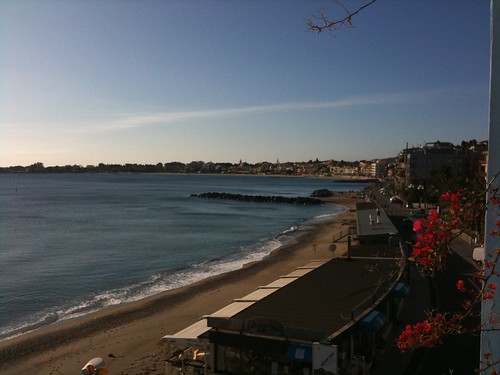
The balcony view from our room at the Hotel Palladio, Giardini Naxos
The festival itself spanned two days, and was held at the Museo Hoffmann, a former fornaccio, or brick factory, now transformed into an eyecatching venue for art. On the first night, poets Salvatore (Salvio) Padrenostro; Sebastiano Burgaretta, a former professor of classical languages and highly regarded folklorist; and Ottavio Fatica, from Rome and one of Italy's most renowned translators of English-language literature, all read. I had the great honor of accompanying Ottavio after he read some of his own poems, when he presented his translations of three poems by one of the greatest American poets of the 20th century, Elizabeth Bishop--"One Art," "Roosters," and "Sonnet"--by reading them in the original English, which he followed with his superb renderings, which managed, despite Italian's quite different rhythms, to preserve Bishop's sense of rhyme and, from what I could tell despite my limited Italian, her particular pitch. I was extremely nervous, but realized as I was reading "One Art" that I could almost have recited that poem from memory so deeply was it etched on my consciousness. I only wish I could understand Italian better so that I could have appreciated all three poets' works, and the fine introductions by Maria, Josephine and Giovanni, so much more. One aspect of the reading that I particularly liked, and wished more American readings included, was a short dialogue between introducer and poet; from what I could tell, it helped warm up the atmosphere, create greater intimacy with the audience, and also offered a window into the poet's aesthetic aims and perspectives. I am going to try to see if this will fly, though I think the almost clockwork manner in which American poetry readings proceeds--intro, reading, Q&A, booksigning if there are books, reception--is pretty set in stone. But perhaps not.
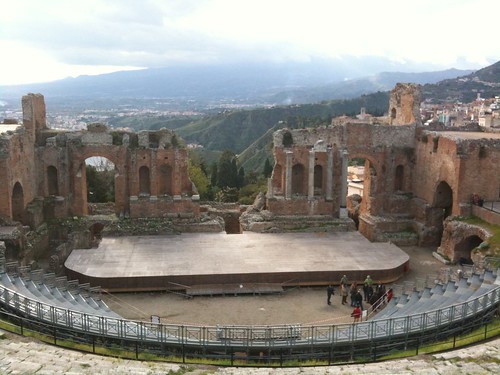
The stage at the Greek Theater, with Giardini Naxos, Schisò, the surrounding regions and the Ionian Sea in the distance
The second night Rosaria LoRusso, hailing from Florence, and I read, and despite again being nervous--so nervous, in fact, that I nearly melted like a torched candle in the museum's chilly catacomb-like halls--I enjoyed myself tremendously. After a lively introduction by and short conversation with Maria, Rosaria read first, and again, though I did not understand the vast majority of what she read, I can say that her passion, particularly in her long, final poem which channeled Hafiz, truly impressed me. In terms of my own reading, I should state for the record that I have taken MR Daniel's and Keith Obadike's great suggestions about "plosives" to heart, and also did not drop 1) the microphone or 2) my papers! I was able to proceed without a hitch. Giovanni offered his introduction, and then we read, I offering short pre-poem patter in English (which most of the audience could not understand, of course), then reading the poems in English, and then Giovanni presented his Italian translations of the poems. (I also want to thank Ottavio, who carefully reviewed all the translations, and offered some great insights, even revealing to me layers I had unconsciously registered in the work.) I was worried that one of my longer poems--I only read 8--"How To Draw a Bunny" would bore the audience to tears, but when Giovanni got into the Italian, they were laughing right along, which was very heartening, because the aim of that piece and the series of which it's a part is to be both funny (in the senses of comical and queer) and profound, as the work of the artists it invokes, Ray Johnson and Nayland Blake, both are. Giovanni had even spotted the allusion to Walter Benjamin in it, and after the reading, when I spoke with a young woman--whose name, I'm so sorry, escapes me--I realized yet other layers, including Jeff Koons's outrageous metallic bunnies, were also signifying in it as well. I also must say that I took a chance I rarely do, to good effect, by trying an interactive, hiphop inspired poem, to bring the audience in. Years ago, shortly after Tupac Shakur died, I wrote an interactive poem on his behalf, which has an aleatory element in it; the final word is epistrophic, which is to say, it can be any word the audience chooses, and repeats throughout the entire poem. I've never read it aloud, perhaps because the opportunity has never presented itself, but when in Giardina Naxos I read online that the Vatican had selected a Tupac song for its official Myspace playlist (???), I knew I had to try it. And, I'm happy to say, I think it worked; certainly everyone got into it, and while I didn't extend it as I might have with an English-speaking audience, everyone got to create the poem and bring the evening to a fitting crescendo. Best of all, C took both pictures and videos of both readings, so I'll be able to post the latter soon so you can see it all for yourself.
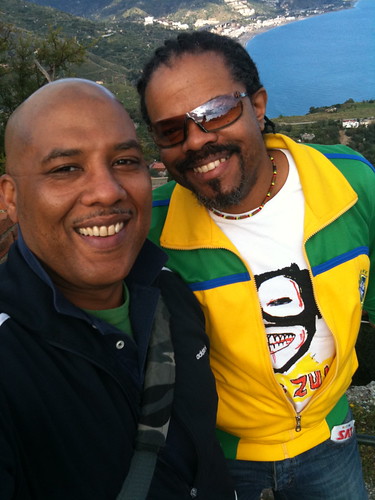
C & I at the Greek Theater
I'll end here by saying that I'm still recovering a bit from jet lag and temporal readjustment, but I also still carry a glow, as well as a great deal of Italian, from this wonderful experience. I cannot recommend Sicily, and especially beautiful little Caltagirone, Giardini Naxos, Taormina, and Catania, enough, and hope we can return for a visit sooner rather than later. I extend my thanks to all whom we encountered, and can say that perhaps more so than any point in my life, to quote Jimmy Santiago Baca's famous line, "Poetry is what we speak to each other." We truly did.

Maria Attanasio introducing Sebastiano Burgaretta
Grazie mille alli mi amichi molti e nuovi e a presto, arrivederci!









Uuuu bettah write!
ReplyDeleteThat was incredible. Now I can't wait for the photos.
ReplyDeleteI agree with C.
You betta write!
How Fantastic!! Sounds like a perfect trip
ReplyDeleteThanks for the shout out and for placing me in such august company as Johnson! Now I'm utterly curious to read the poem. Where can I track it down?
ReplyDeletewww.naylandblake.net
Dear C, Anthony and Reggie, thanks for the good words!
ReplyDeleteNayland, the poem hasn't been published yet, but I'll send a copy your way if there's a link via your website. If not, let me know and I'll send you my email address! Thanks for reading.